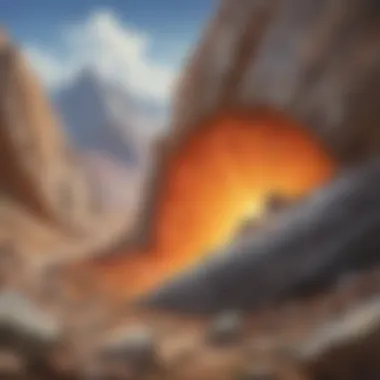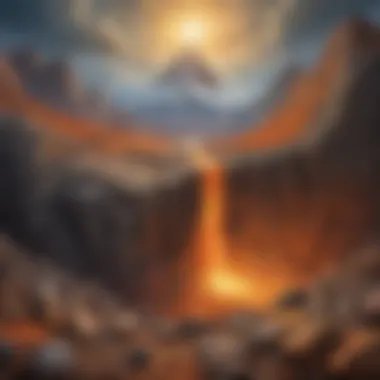Unveiling the Intricacies of the Rock Cycle: A Geological Journey


Science Fun Facts
As we delve into the fascinating world of the rock cycle, there are some intriguing fun facts to uncover. Did you know that rocks can undergo three main types of rock cycles: igneous, sedimentary, and metamorphic? Each cycle involves its own set of processes that transform rocks into different forms over eons. For instance, igneous rocks are formed from the cooling of molten lava or magma, while sedimentary rocks are created from the accumulation and compression of sediments. Metamorphic rocks, on the other hand, are rocks that have changed their form due to intense heat and pressure deep within the Earth's crust.
Discover the Wonders of Science
Exploring the rock cycle unveils various scientific concepts that showcase the dynamic nature of Earth's geological processes. Educational videos and animations can visually depict how rocks are continuously evolving and changing. By understanding the rock cycle, we gain insight into the intricate ways in which rocks shape the Earth's surface over time. Real-life applications of the rock cycle can be seen in the formation of mountain ranges, volcanic activity, and the creation of minerals essential for various industries.
Science Quiz Time
Engage in interactive quizzes that test your knowledge of the rock cycle. Answer multiple choice questions that challenge your understanding of rock formation and transformation. Dive into brain teasers and puzzles that stimulate critical thinking and problem-solving skills related to geological science. Through gamification, learning about the rock cycle becomes a fun and engaging experience, allowing you to grasp the complexities of geological processes in an interactive and entertaining manner.
Science Experiment Showcase
Embark on exciting experiments that illustrate the principles of the rock cycle. Follow step-by-step instructions to conduct hands-on activities that mimic the formation of rocks through various stages. Equip yourself with the necessary materials listed to perform these experiments safely and effectively. Learn about safety tips and precautions to ensure a successful and educational exploration of the rock cycle, fostering a deeper appreciation for the science behind Earth's ever-changing crust.
Introduction to the Rock Cycle
In this section, we unravel the complex processes that constitute the rock cycle, shedding light on the continuous evolution of rocks through various geological events. By dissecting the stages of the rock cycle meticulously, readers will gain a profound insight into the transformative journey of rocks, emphasizing the ever-changing nature of Earth's crust. Exploring the intricacies of the rock cycle is paramount in understanding the geological heartbeat of our planet.
Definition of the Rock Cycle
Understanding the Concept
Delving into the concept of the rock cycle, we aim to decipher the cyclical nature of rock formation, illustrating how rocks undergo a perpetual transformation over time. Understanding the nuances of this concept provides a foundational understanding of Earth's geological processes, enabling us to appreciate the dynamic interplay between various rock types. The key characteristic of comprehending the rock cycle lies in grasping the interconnectedness of geological events, portraying a holistic picture of Earth's rocky evolution. This approach proves to be instrumental in unraveling the mysteries hidden within Earth's crust.
Incorporating Various Geological Processes


Incorporating a diverse range of geological processes into the study of the rock cycle enriches our comprehension of rock formation mechanisms. By considering processes such as deposition, erosion, and metamorphism, we can analyze how different forces shape and mold rocks into their distinct forms. This integration facilitates a comprehensive exploration of rock cycle dynamics, providing a multifaceted understanding of the Earth's geological narrative. The unique feature of intertwining various geological processes lies in its ability to unveil the interconnected web of Earth's geological history, offering a nuanced perspective on the rock cycle's evolutionary journey.
Significance of the Rock Cycle
Impact on Earth's Structure
The rock cycle plays a pivotal role in shaping Earth's structure, influencing the composition and arrangement of rocks in the planet's crust. This impact extends far beyond surface appearances, as the rock cycle determines the resilience and stability of Earth's geological makeup. Understanding how the rock cycle influences Earth's structure sheds light on the profound interconnection between geological processes and the planet's physical framework. The significance of this interplay underscores the fundamental role that the rock cycle plays in sculpting the very essence of our planet.
Role in Geological Evolution
The rock cycle serves as a cornerstone in Earth's geological evolution, acting as a key driver in the transformation of rocks over geologic timescales. By tracing the history of rocks through the lens of the rock cycle, we uncover the intricate tapestry of Earth's past, deciphering the enduring legacy of geological events. The role of the rock cycle in geological evolution illuminates the interconnected nature of Earth's geological phenomena, highlighting the cyclical nature of rock transformations. This inherent connection underscores the integral role of the rock cycle in unraveling the geological narrative of our planet.
Types of Rocks
Igneous Rocks
Formation and Characteristics
At the heart of the rock cycle lie igneous rocks, born from the fiery depths of the Earth. Their formation begins with the cooling and solidification of molten magma deep within the Earth's mantle or during volcanic eruptions. This process enables igneous rocks to exhibit a crystalline structure, ranging from fine-grained textures in volcanic rocks to coarse-grained in plutonic rocks. The unique characteristic of igneous rocks lies in their mineral composition, often rich in elements like silicon, oxygen, aluminum, and iron. The significance of igneous rocks in this article lies in their role as primary indicators of the planet's geological history. By studying their formation and characteristics, researchers can unravel the intricate processes and conditions that have shaped the Earth over millions of years. Understanding the diversity within igneous rocks provides a foundation for interpreting past geological events and predicting future transformations.
Examples of Igneous Rocks
Delving into the realm of igneous rocks reveals a vast array of examples that showcase the diversity and complexity of these formations. From the majestic granite, with its interlocking crystals and durable composition, to the colorful basalt, formed from rapid cooling lava flows, each igneous rock type tells a unique story about the Earth's dynamic past. The examples of igneous rocks presented in this article serve as windows into the diverse environments and conditions under which these rocks were formed. By examining the key characteristics and properties of various igneous rocks, we gain a deeper appreciation for the intricacies of the rock cycle and the geological forces at play.
Key Processes in the Rock Cycle
In the grand scheme of geological systems, the key processes in the rock cycle play a pivotal role in perpetuating Earth's dynamic evolution. Essential components like weathering, erosion, heat, pressure, melting, and cooling orchestrate a symphony of transformation that shapes our planet's crust. Weathering and erosion, the initial protagonists in this saga, relentlessly sculpt and wear down rocks, paving the way for their metamorphosis. Heat and pressure then step onto the stage, instigating dramatic transformations in texture, structure, and composition. Melting and cooling bring a climactic resolution, solidifying the metamorphic journey of rocks. Together, these processes orchestrate the awe-inspiring cycle of rock formation and alteration, offering a glimpse into the wondrous forces that drive Earth's geological tapestry.


Weathering and Erosion
Influence on Rock Formation
Weathering and erosion serve as the silent architects of rock formation, quietly reshaping the landscape through relentless decay and transportation. The insistent caress of elemental forces gradually breaks rocks down into sediments, creating the raw materials for future geological creations. Through processes like physical abrasion and chemical decomposition, weathering and erosion foster the genesis of new rock formations, perpetuating the cycle of creation and destruction that defines Earth's crust.
Effects of Weathering and Erosion
The effects of weathering and erosion are profound, sculpting the very face of our planet and influencing the distribution of rocks across landscapes. As rocks succumb to the relentless forces of weathering and erosion, their intricate textures and compositions are laid bare, revealing the hidden stories of their formation. While these processes may seem destructive, they lay the foundation for new beginnings, reshaping terrains and fostering the creation of diverse geological formations. Despite their seemingly transient nature, weathering and erosion play a fundamental role in the perpetual dance of rock evolution.
Heat and Pressure
Role in Rock Transformation
Heat and pressure act as the master alchemists of rock transformation, exerting immense forces to mold and recast rocks into new configurations. Under the intense heat and pressure of Earth's depths, rocks undergo profound changes, transitioning from one form to another in a geological metamorphosis. This relentless process of transformation imbues rocks with unique textures, properties, and characteristics, highlighting the profound impact of heat and pressure on Earth's geological heritage.
Impact on Rock Properties
The effects of heat and pressure on rocks are transformative, imbuing them with unparalleled strength, resilience, and durability. Through the crucible of geological forces, rocks emerge revitalized and endowed with enhanced properties, reflecting the crucible that forges them. While the influence of heat and pressure may go unnoticed to the casual observer, its effects reverberate throughout the geological landscape, shaping the very foundation of our planet's crust.
Melting and Cooling
Contribution to Igneous Rock Formation
Melting and cooling usher in the final act of the rock cycle, culminating in the birth of igneous rocks from the fiery depths of Earth's core. As rocks melt under intense temperatures, they undergo a profound metamorphosis, transitioning into molten magma that flows and cools to form new igneous formations. This transformative process not only generates new rock compositions but also contributes to the geological diversity that defines Earth's crust.
Effects on Geological Structures


The effects of melting and cooling on geological structures are profound, shaping the very fabric of Earth's landscapes. As molten magma cools and solidifies, it gives rise to intricate geological formations, from towering mountains to expansive plains. The interplay of melting and cooling not only influences the physical characteristics of rocks but also determines the topographical features that define our planet's surface. Through this transformative process, the legacy of melting and cooling is etched into the very heart of Earth's geological narrative.
Cycles of Rock Formation
In the holistic exploration of the rock cycle, delving into the concept of Cycles of Rock Formation emerges as a pivotal juncture. Understanding the cyclic nature of rock transformation provides profound insights into the dynamic geological processes at play. It serves as the foundational framework upon which rocks evolve over time, showcasing the interconnectedness of various geological phenomena. The significance of comprehending Cycles of Rock Formation lies in unraveling the intricate sequences of events that lead to the continuous metamorphosis of Earth's crust, offering a glimpse into the profound changes shaping our planet's landscape.
Continuous Transformation
Overview of the Cycle
The segment focusing on the Overview of the Cycle encapsulates a comprehensive view of how rocks metamorphose through evolving stages. It outlines the sequential progression of rocks from one form to another, shedding light on the perpetual transformation that characterizes the rock cycle. This facet serves as a cornerstone in comprehending the cyclical nature of geological processes, highlighting the cyclical nature of rock formations. By unraveling the nuances of the Overview of the Cycle, readers embark on a journey to grasp the essence of rock evolution, emphasizing the dynamic interplay of forces shaping Earth's geological landscape.
Interaction of Processes
Within the realm of the rock cycle, the Interaction of Processes emerges as a fundamental element dictating the trajectory of rock transformations. Analyzing the intricate interplay between weathering, erosion, heat, pressure, and melting mechanisms, this aspect elucidates how different geological forces intricately mold rocks over time. By elucidating the dynamic interaction of processes, this subsection unveils the synergistic relationship between various geological phenomena, enriching our understanding of the complexities underlying rock formation. Delving deeper into the Interaction of Processes unravels the multidimensional nature of rock evolution and its profound impact on shaping Earth's geological diversity.
Role of Tectonic Movements
Impact on Rock Cycle
Exploring the Impact on Rock Cycle unveils the profound influence of tectonic movements in driving the continuous transformation of rocks. By scrutinizing how tectonic forces catalyze geological changes, this aspect underscores the indispensable role played by tectonic movements in sculpting Earth's crust. This segment sheds light on how tectonic dynamics act as catalysts in reshaping rock formations, offering valuable insights into the dynamic interplay between tectonic movements and the rock cycle evolution.
Connection to Plate Tectonics
Drawing a correlation between tectonic movements and plate tectonics, the Connection to Plate Tectonics section unveils the intrinsic link between these phenomena. It elucidates how plate tectonics influence tectonic movements, cascading into significant geological transformations. By examining the interconnected nature of tectonic movements and plate tectonics, readers gain a deeper understanding of how these mechanisms collaboratively shape Earth's geological features, underscoring the paramount importance of comprehending their interdependency.
Environmental Factors
Influence on Rock Formation
Analyzing the Influence on Rock Formation provides insights into how environmental factors intricately influence rock evolution. By dissecting the impact of environmental variables on rock composition and structure, this segment illuminates the intricate interplay between environmental conditions and rock formation processes. Unraveling the pivotal role of environmental factors in shaping rocks offers a nuanced perspective on how external elements sculpt Earth's geological diversity, unveiling the multifaceted relationship between environmental influences and rock evolution.
Relationship to Climate Changes
Exploring the Relationship to Climate Changes delves into the profound connection between climatic variations and rock evolution. By elucidating how climate fluctuations catalyze geological transformations, this section unveils the dynamic interplay between climate changes and rock formations. Understanding the intricate relationship between climate shifts and geological processes is paramount in deciphering how rocks respond to environmental stimuli, underscoring the holistic impact of climatic variations on Earth's geological landscape.







